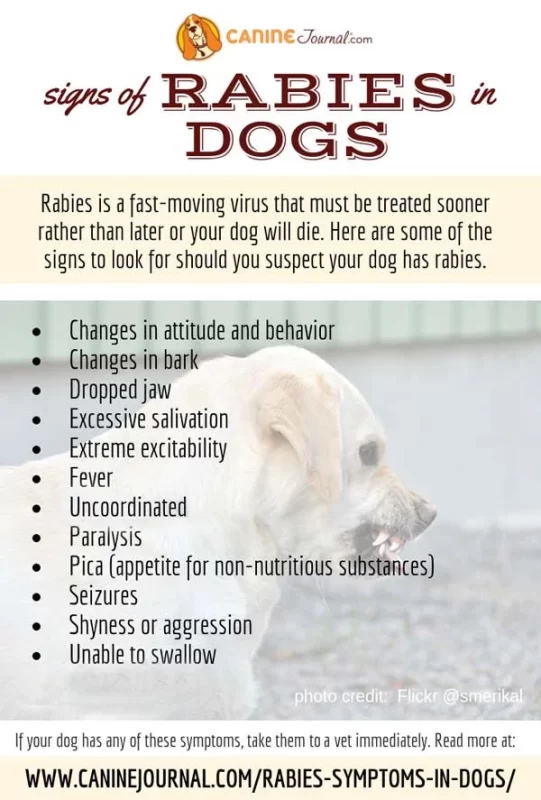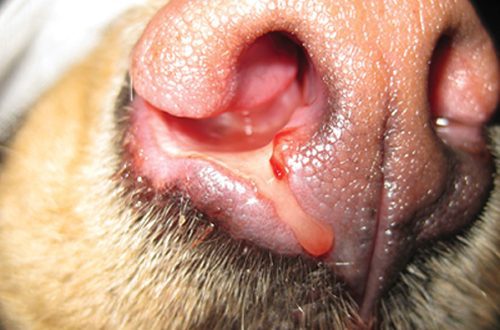
Све о беснилу код паса
Since ancient times, animals and people have been suffering from a terrible disease – rabies. This disease is caused by a virus that attacks the central nervous system and can be fatal. Rabies mainly affects mammals, which include dogs.
Садржај
Узроци и симптоми болести
The main cause of rabies is the bite of an infected animal and the rapid penetration of the virus with saliva into a scratch or wound. Infection occurs less frequently when saliva enters the damaged mucous membranes of the eyes, nose, and mouth. Small amounts of the virus can be shed through urine and feces. It appears in saliva about 10 days before the onset of the first symptoms, accumulates and multiplies in nerve cells, reaching the spinal cord and brain. After entering the salivary glands, the virus is released along with saliva to the outside. Infection can go unnoticed for a long time. The incubation period varies in dogs from 2 weeks to 4 months.
Symptoms of rabies in dogs include:
- At the initial stage (1-4 days), the dog becomes lethargic, lethargic. Some animals can constantly ask the owner for attention and affection, follow him on his heels.
- During the excitation stage (2-3 days), the dog becomes too aggressive, shy, he begins to have water and photophobia. It becomes difficult for him to drink water due to paralysis of the pharynx and larynx. The dog’s salivation increases, because of which he tries to lick himself endlessly. A person runs the risk of contracting rabies at this stage, as the pet can pounce on him and bite him.
- The paralytic stage (2–4 days) precedes death. The dog stops moving, expressing emotions, refuses to eat. She can be shaken by severe convulsions, damage to internal organs begins, and coma occurs.
In addition to the three main stages of the manifestation of rabies, there are also such forms as atypical, remitting and abortive. In the first case, lasting six months, the dog is not aggressive, but lethargic. In the second form, symptoms may come and go, making it difficult to identify rabies. The latter form is not well studied and is rare. But it is the only one in which the dog recovers on its own, without treatment. The symptoms can be quite different from case to case.
Treating rabies in dogs
Unfortunately, there is no cure for rabies in dogs. Usually sick animals are isolated at the first sign of the disease, and then euthanized. For the prevention of rabies, it is necessary to vaccinate pets older than three months annually. During the active period of the vaccine, the dog will be protected even in direct contact with an infected animal. A rabies vaccination for a dog reduces the risk of infection by up to 1%.
How to prevent the disease?
Rabies is one of the infectious diseases that is 100% preventable by vaccination of wild and domestic animals. It is necessary to vaccinate pets against rabies on the territory of the Russian Federation once a year. Vaccination against rabies is provided free of charge at regional animal disease control stations.
Also, owners must follow the safety rules for their pets: protect them from contact with stray dogs and other animals, keep them in sight on country walks.
Why is rabies dangerous to humans and is it transmitted to other animals?
Dog bites are the main source of rabies in humans. Dog bites to the head, neck, face and hands are considered the most dangerous due to the large number of nerves located there. Humans can also become infected with rabies through scratches caused by an infected dog’s claws. Stray dogs are a particular danger to humans and domestic dogs. The consequences of infection are convulsions of the pharyngeal and respiratory muscles, the onset of paralysis and death. After the onset of symptoms of rabies, a person dies in 5-12 days, a diseased animal – in 2-6 days.
Most often, rabies occurs among dogs, cats, foxes, raccoons, ferrets, hedgehogs, wolves, bats. It is in natural conditions that wild animals not only preserve, but also spread the RNA-containing virus. Its consequences are local changes in brain tissue, swelling and hemorrhage along with degenerative cellular changes.
If you are bitten by an unfamiliar animal, wash the wound thoroughly with disinfectant solutions and seek appropriate medical treatment as soon as possible. If your pet is bitten, if possible, clean the wound as well and take it to an appointment at the district animal disease control station





